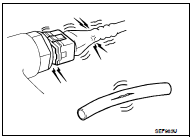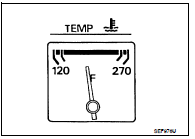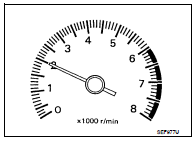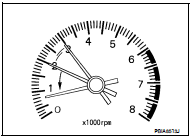Nissan Altima (L32) 2007-2012 Service Manual: Basic inspection
Special Repair Requirement
1.INSPECTION START
1. Check service records for any recent repairs that may indicate a related malfunction, or a current need for scheduled maintenance.
2. Open engine hood and check the following: - Harness connectors for improper connections
- Wiring harness for improper connections, pinches and cut
- Vacuum hoses for splits, kinks and improper connections
- Hoses and ducts for leaks
- Air cleaner clogging
- Gasket
3. Confirm that electrical or mechanical loads are not applied.
- Headlamp switch is OFF.
- Air conditioner switch is OFF.
- Rear window defogger switch is OFF.
- Steering wheel is in the straight-ahead position, etc.
4. Start engine and warm it up until engine coolant temperature indicator points the middle of gauge.
Ensure engine stays below 1,000 rpm.


5. Run engine at about 2,000 rpm for about 2 minutes under no load.
6. Make sure that no DTC is displayed with CONSULT-III or GST.
Is any DTC detected? YES >> GO TO 2.
NO >> GO TO 3.

2.REPAIR OR REPLACE
Repair or replace components as necessary according to corresponding Diagnostic Procedure.
>> GO TO 3
3.CHECK TARGET IDLE SPEED
1. Run engine at about 2,000 rpm for about 2 minutes under no load.
2. Rev engine (2,000 to 3,000 rpm) two or three times under no load, then run engine at idle speed for about 1 minute.
3. Check idle speed.
For procedure, refer to EC-564, "IDLE SPEED : Special Repair Requirement".For specification, refer to EC-1043, "Idle Speed".
Is the inspection result normal? YES >> GO TO 10.
NO >> GO TO 4.

4.PERFORM ACCELERATOR PEDAL RELEASED POSITION LEARNING
1. Stop engine.
2. Perform EC-565, "ACCELERATOR PEDAL RELEASED POSITION LEARNING : Special Repair Requirement".
>> GO TO 5.
5.PERFORM THROTTLE VALVE CLOSED POSITION LEARNING
Perform EC-565, "THROTTLE VALVE CLOSED POSITION LEARNING : Special Repair Requirement".
>> GO TO 6.
6.PERFORM IDLE AIR VOLUME LEARNING
Perform EC-566, "IDLE AIR VOLUME LEARNING : Special Repair Requirement".
Is Idle Air Volume Learning carried out successfully? YES >> GO TO 7.
NO >> Follow the instruction of Idle Air Volume Learning. Then GO TO 4.
7.CHECK TARGET IDLE SPEED AGAIN
1. Start engine and warm it up to normal operating temperature.
2. Check idle speed.
For procedure, refer to EC-564, "IDLE SPEED : Special Repair Requirement".For specification, refer to EC-1043, "Idle Speed".
Is the inspection result normal? YES >> GO TO 10.
NO >> GO TO 8.
8.DETECT MALFUNCTIONING PART
Check the Following.
• Check camshaft position sensor (PHASE) and circuit. Refer to EC-787, "DTC Logic".
• Check crankshaft position sensor (POS) and circuit. Refer to EC-783, "DTC Logic".
Is the inspection result normal? YES >> GO TO 9.
NO >> Repair or replace. Then GO TO 4.
9.CHECK ECM FUNCTION
1. Substitute another known-good ECM to check ECM function. (ECM may be the cause of an incident, but this is a rare case.) 2. Perform initialization of NVIS (NATS) system and registration of all NVIS (NATS) ignition key IDs. Refer to EC-563, "ADDITIONAL SERVICE WHEN REPLACING CONTROL UNIT : Special Repair Requirement".
>> GO TO 4.
10.CHECK IGNITION TIMING
1. Run engine at idle.
2. Check ignition timing with a timing light.
For procedure, refer to EC-564, "IGNITION TIMING : Special Repair Requirement".For specification, refer to EC-1043, "Ignition Timing".
Is the inspection result normal? YES >> GO TO 19.
NO >> GO TO 11.

11.PERFORM ACCELERATOR PEDAL RELEASED POSITION LEARNING
1. Stop engine.
2. Perform EC-565, "ACCELERATOR PEDAL RELEASED POSITION LEARNING : Special Repair Requirement".
>> GO TO 12.
12.PERFORM THROTTLE VALVE CLOSED POSITION LEARNING
Perform EC-565, "THROTTLE VALVE CLOSED POSITION LEARNING : Special Repair Requirement".
>> GO TO 13.
13.PERFORM IDLE AIR VOLUME LEARNING
Perform EC-566, "IDLE AIR VOLUME LEARNING : Special Repair Requirement".
Is Idle Air Volume Learning carried out successfully? YES >> GO TO 14.
NO >> Follow the instruction of Idle Air Volume Learning. Then GO TO 4.
14.CHECK TARGET IDLE SPEED AGAIN
1. Start engine and warm it up to normal operating temperature.
2. Check idle speed.
For procedure, refer to EC-564, "IDLE SPEED : Special Repair Requirement".For specification, refer to EC-1043, "Idle Speed".
Is the inspection result normal? YES >> GO TO 15.
NO >> GO TO 17.
15.CHECK IGNITION TIMING AGAIN
1. Run engine at idle.
2. Check ignition timing with a timing light.
For procedure, refer to EC-564, "IGNITION TIMING : Special Repair Requirement".For specification, refer to EC-1043, "Ignition Timing".
1 : Timing indicator
Is the inspection result normal? YES >> GO TO 19.
NO >> GO TO 16.

16.CHECK TIMING CHAIN INSTALLATIO
Check timing chain installation. Refer to EM-52, "Removal and Installation".
Is the inspection result normal? YES >> GO TO 17.
NO >> Repair the timing chain installation. Then GO TO 4.
17.DETECT MALFUNCTIONING PART
Check the following.
• Check camshaft position sensor (PHASE) and circuit. Refer to EC-787, "DTC Logic".
• Check crankshaft position sensor (POS) and circuit. Refer to EC-783, "DTC Logic".
Is the inspection result normal? YES >> GO TO 18.
NO >> Repair or replace. Then GO TO 4.
18.CHECK ECM FUNCTION
1. Substitute another known-good ECM to check ECM function. (ECM may be the cause of an incident, but this is a rare case.) 2. Perform initialization of NVIS (NATS) system and registration of all NVIS (NATS) ignition key IDs. Refer to EC-563, "ADDITIONAL SERVICE WHEN REPLACING CONTROL UNIT : Special Repair Requirement".
>> GO TO 4.
19.INSPECTION END
If ECM is replaced during this BASIC INSPECTION procedure, go to EC-27, "ADDITIONAL SERVICE WHEN REPLACING CONTROL UNIT : Special Repair Requirement".
>> INSPECTION END

 Inspection and adjustment
Inspection and adjustment Additional service when replacing
control unit
Additional service when replacing
control unit